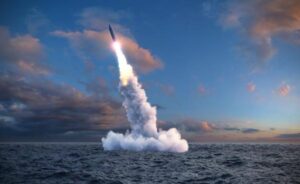Ballistic missiles and conventional strike weapons
Adapting the HCoC to address the dissemination of conventional ballistic missiles
HCOC RESEARCH PAPERS NO. 6
The Hague Code of Conduct aims at curbing the proliferation of missiles capable of carrying weapons of mass destruction. Today, with an important increase in ranges, these weapons are more and more used for a conventional mission, by a variety of states. This dissemination illustrates the fact that many stakeholders master the technologies necessary to build and sustain these weapons. But it also raises questions on the possible destabilising effects of these arsenals, even when they are not linked to WMDs.
This paper develops the factors that have led to a reconsideration of the use of ballistic missiles for conventional strikes, and evokes possible ways for the HCoC to react to this evolution.
Specifically, it proposes three options for the HCoC. First, it could continue to draw attention to the proliferation of missiles, regardless of their vocation. Second, an extension of the scope of the Code could be considered, which could extend its field of action to include regional security and stabilisation. Third, the Code could focus less on the delivery vehicle itself and more on the payload, enabling it to refer to all missiles carrying WMDs. This final proposition is described as more complex but potentially interesting as it would provide for regulation of emerging technologies such as hypersonic glide vehicles.
JANUARY 2020
Stéphane Delory
CONTENTS
“The Hague Code of Conduct was designed at a time when the proliferation of ballistic missiles was closely associated with that of weapons of mass destruction. However, the HCoC is now faced with changes in ballistic technology which fundamentally alter the link between ballistic missiles and weapons of mass destruction. Over short ranges, ballistic missiles are increasingly used for conventional strike missions.”
The Hague Code of Conduct was designed at a time when the proliferation of ballistic missiles was closely associated with that of weapons of mass destruction. However, the HCoC is now faced with changes in ballistic technology which fundamentally alter the link between ballistic missiles and weapons of mass destruction. Over short ranges, ballistic missiles are increasingly used for conventional strike missions. The same development holds true, more gradually, for longer–range missiles.1
The Code aims to prevent the proliferation of ballistic weapons ‘capable of delivering weapons of mass destruction’, and not ballistic missiles per se. This phrasing suggests a possible distinction based on the purpose of the missiles and, therefore, that no anti–proliferation mechanism exists for missiles whose purpose is exclusively conventional. In this regard, the Code could be adapted to take into account conventional ballistic missiles. But this distinction is clearly specious: by definition, any ballistic missile2 is capable of delivering weapons of mass destruction.3 We must attempt to define the parameters involved in conventional applications of ballistic missiles and decide how to take these into account.
By making no reference to payload or range, the Code differs from the initial approach of the Missile Technology Control Regime (MTCR). By defining minimal criteria (a range of 300 km and a payload of 500 kg), the MTCR distinguished between missiles subject to regulation and those weapons or technologies that could be freely exported. These criteria were heavily inspired by the technical features of the SS–1c Scud and first–generation nuclear weapons. They applied to the main types of missile proliferated by states in search of delivery systems for weapons of mass destruction, and were therefore probably sufficient to halt the proliferation of such systems in the 1980s and 1990s. However, these criteria have turned out to be poorly suited to subsequent technological developments. They now apply to a majority of weapons and technologies whose purposes are primarily conventional. By leaving the MTCR’s range and payload criteria unchanged, the Code has diverged fundamentally from the MTCR, whose implicit objective is to regulate the proliferation of missiles in their own right, and not just delivery systems for weapons of mass destruction.
The Code and the MTCR may reflect different methodological approaches, but they face the same problem: How can prevention and anti-proliferation measures take account of weapons and technologies whose applications are primarily conventional? And how can these be distinguished from delivery systems for weapons of mass destruction?
The question is far from merely rhetorical. By focusing solely on ‘ballistic missiles capable of delivering weapons of mass destruction’, the Code emphasises a fundamental principle: that states are permitted the equipment of their choice in order to defend themselves, as long as this is not prohibited or restricted by international treaties. The MTCR does not go against this principle, nor do the United Nations Security Council resolutions passed during proliferation crises. The member states of the MTCR voluntarily undertake to regulate certain types of exports, with no normative consequence under international law. Security Council resolutions, which ban particular states from acquiring ballistic missiles, establish a direct link between such missiles and illegal programmes to acquire weapons of mass destruction. Resolution 1540, whose scope is more general, requires states to establish measures to control the proliferation of both weapons of mass destruction and their delivery systems. Like the Code and previous resolutions, it makes a distinction between delivery systems in their own right and delivery systems associated with weapons of mass destruction. Since there is no international treaty prohibiting the design, development, acquisition, and export of ballistic weapons, all of these actions are legal as long as they are carried out in conformity with the respective commitments of states to non-proliferation agreements and international standards.[…]
1 In this paper, very short-range missiles are defined as those with a range of less than 300 km, short-range missiles as those with a range of less than 800 km, and long-range missiles as those with a range of over 1,000 km. In terms of conventional strikes, missiles with ranges greater than 1,000 km are rare, and the majority are not precise enough to generate a predictable military effect on the target. Instead, they are primarily used for “political” strikes—that is, those aimed at civilian targets which are meant to force the targeted political power to change its military position in a conflict.
2 In speaking of ballistic missiles here, we include those with manoeuvrable warheads and quasi-ballistic missiles (which spend the majority of their flight within the atmosphere). Guided heavy rockets (missiles of 600 mm and above) are treated as ballistic missiles, as the traditional distinction between these systems and ballistic missiles (in terms of range, trajectory, and type of guidance system) is fading.
3 In fixing the payload limit for regulated missiles at 500 kg, the MTCR was guided by the minimum carrying capacity of a first-generation nuclear missile. However, proliferating nuclear powers and those who are not members of the Treaty on the Non-Proliferation of Nuclear Weapons (NPT) are now capable of designing weapons whose mass is likely lower. Furthermore, the Syrian conflict reminds us that the use of chemical weapons remains a current problem. The increasing precision of missiles makes it possible to reduce the quantity of chemical agents needed to produce a significant military effect. We should take heed of cases in which low-payload delivery systems are used to carry chemical weapons.




